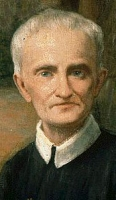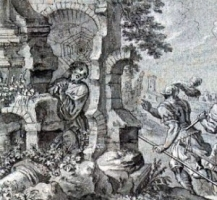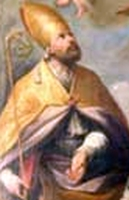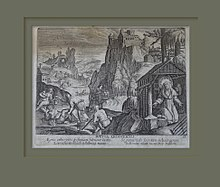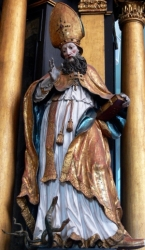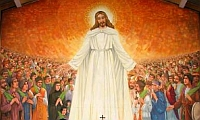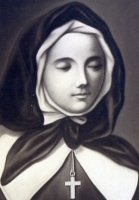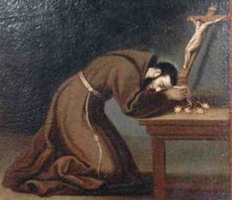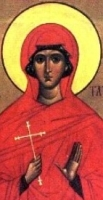Blessed Petrus Donders
Also known as
Peter, Peerke
Profile
Son of Arnold Denis Donders and Petronella van den Brekel. Peter grew up poor, rarely getting to school, working at home and in a local factory with his brother Martin, and dreaming of becoming a priest. With the help of local priests and a wealthy patron, he enter the seminary at the College of Herlaar at age twenty-two, initially working as a servant while he studied. At age twenty-six her applied to the Franciscans, Jesuits and Redemptorists, but was turned down by each. Ordained on 5 June 1841 after nearly ten years of work.
Missionary to the Dutch colony in Surinam, Dutch Guiana, arriving in Paramaribo on 16 September 1842. Evangelized and ministered to plantation slaves, constantly in touch with his superiors to complain of the terrible treatment of the workers. He baptized at least 1200 in his first couple of years, and worked among the sick during an epidemic in 1851. Transferred to the leper colony of Batavia in 1856. There he ministered to both the body and soul of the 600 or so patients. His constant harassment of the colonial authorities resulted in much better care for the patients.
When the Redemptorists arrived in Surinam in 1866 to take charge of the mission, Peter joined the Order, becoming a 57 year old novice in 1866, and making his final vows on 24 June 1867. He then returned to Batavia with a crew of Redemptorists ready to help the lepers. With the added help, Father Peter expanded his work, and began to evangelize the Indians in the region. He learned their languages and had made a good start on the work when his health failed. His superiors transferred him to easier assignments, but as the end approached, Peter returned to Batavia where he worked with the patients until his end.
Born
27 October 1805 at Tilburg, North Brabant, Netherlands
Died
• 14 January 1887 at Batavia, Saramacca, Surinam of natural causes
• buried there
Beatified
• 23 May 1982 by Pope John Paul II
• on 11 April 1978, the Congregation for the Causes of Saints declared miraculous the cure of Louis John Westland from osteomyelitis by Blessed Peter's intercession
Saint Felix of Nola
நோலா நகர் புனிதர் ஃபெலிக்ஸ்
குரு:
பிறப்பு: கி.பி. 3ம் நூற்றாண்டின் ஆரம்பம்
நோலா, கம்பானியா, இத்தாலி
இறப்பு: கி.பி. 250
நோலா, கம்பானியா, இத்தாலி
ஏற்கும் சமயம்:
ரோமன் கத்தோலிக்க திருச்சபை
மரபுவழி திருச்சபை
நினைவுத் திருநாள்: ஜனவரி 14
பாதுகாவல்: நோலா, இத்தாலி
நோலா நகர் புனிதர் ஃபெலிக்ஸ், இத்தாலி (Italy) நாட்டின் பண்டைய "நேப்பிள்ஸ் மற்றும் சிசிலி" (Naples and Sicily) இராச்சியங்களின் தலைநகரான "நேப்பிள்ஸ்" (Naples) நகரில் வசித்திருந்த கிறிஸ்தவ குரு ஆவார். அவர், ஏழைகளுக்குக் கொடுக்கும் பொருட்டு தமது உடைமைகளை விற்றார். ஆனால், ரோமப் பேரரசன் "டேசியஸ்" (Roman emperor Decius) என்பவனது ஆட்சி காலத்தில் கைது செய்யப்பட்டு, கிறிஸ்தவ விசுவாசத்திற்காக துன்புறுத்தப்பட்டார். அவர், ரோமப் பேரரசன் "டேசியஸ்" அல்லது "வலேரியன்" ஆகியோரது துன்புறுத்தலின்போது ஒரு மறைசாட்சியாக மரித்துவிட்டார் என்று நம்பப்படுகிறது. ஆனால், வாழும் காலத்தில் சித்திரவதைகளை அனுபவித்த இவர், கத்தோலிக்கர்களின் பொது நாள்காட்டியில் (General Roman Calendar), விசுவாசத்தின் ஒப்புரவாளராக (Confessor of the Faith) பட்டியலிடப்பட்டுள்ளார்.
ஃபெலிக்ஸ், சிரியா நாட்டில், ரோம இராணுவத்தில் (Syrian Centurion) பணியாற்றி, இத்தாலியிலுள்ள நோலா நகரில் ஓய்வு பெற்ற "ஹெர்மியாஸ்" (Hermias) என்பவரது மகன் ஆவார். தமது தந்தையின் மரணத்திற்குப் பிறகு, ஃபெலிக்ஸ் தமக்குள்ள சொத்துக்கள் மற்றும் உடைமைகள் அனைத்தையும் விற்று, அதன் வருமானத்தை ஏழைகளுக்கு அளித்தார். தாம் ஆன்மீக வாழ்க்கை முறையை பின்பற்றினார். ஆயர் (Bishop) தூய "மேக்சிமஸ்" (Saint Maximus of Nola) என்பவரால் குருத்துவ அருட்பொழிவு அளிக்கப்பட ஃபெலிக்ஸ், அவருடனேயே பணியாற்றினார்.
ரோம பேரரசர் "டேசியஸின்" (Decius) கிறிஸ்தவ துன்புறுத்துதல்களுக்குப் பயந்து, ஆயர் மேக்சிமஸ் மலைகள் மீது ஒடி ஒளிந்தபோது, அரச படைகளால் ஃபெலிக்ஸ் கைது செய்யப்பட்டார். மற்றும் அதற்கு பதிலாக அவருடைய விசுவாசத்திற்கு அடித்து துன்புறுத்தப்பட்டார். புராணங்களின்படி, ஒரு தேவதூதரால் விடுவிக்கப்பட்ட அவர், சிறைச்சாலையில் இருந்து தப்பியோடினார். அதனால் ஆயர் மேக்சிமஸுக்கு உதவ அவரால் முடிந்தது. ஆயர் மேக்சிமஸை, தனியாகவும், நோயுற்றவராகவும், உதவியற்றவராகவும் கண்ட ஃபெலிக்ஸ், ஒரு காலியாக இருந்த ஒரு கட்டிடத்தில் அரச வீரர்களிடமிருந்து அவரை மறைத்து வைத்தார்.
இருவரும் பாதுகாப்பாக உள்ளே இருந்தபோது, ஒரு சிலந்தி சடுதியில் செயல்பட்டு, அவர்களிருந்த அறையின் கதவை மறைத்தவாறு ஒரு வலையைப் பின்னியது. முட்டாளாக்கப்பட்ட அரச படையினர், சிந்தித்தவாறே, இது கைவிடப்பட்ட மிகவும் பழைய கட்டிடம் என்றவாறு, ஒளிந்திருந்த கிறிஸ்தவர்களை கண்டுபிடிக்க இயலாமல் திரும்பிச் சென்றனர். ஃபெலிக்ஸ்ஸை கைது செய்வதற்கான ஒரு தொடர்ச்சியான முயற்சி தொடர்ந்து மீண்டும் நடந்தது. ஆனால், முன்பு போலவே அந்த சிலந்தி செயல்பட்டு அவரை மறைத்தது. கி.பி. 251ம் ஆண்டு, பேரரசன் டேசியஸ் இறந்து, கிறிஸ்தவ துன்புறுத்தல்கள் முடிவடையும் வரையில் இருவரும் மறைந்திருந்தனர்.
ஆயர் மேக்சிமஸின் மரணத்திற்குப்பின், ஃபெலிக்ஸ் அடுத்த நோலாவின் ஆயர் ஆக மக்கள் விரும்பினர். ஆனால், அவர் தம்மை விட ஏழு நாட்கள் அனுபவம் கொண்ட ஒரு மூத்த குரு "குயிண்டஸ்" (Quintus) என்பவர் இருப்பதால் ஆயர் பதவியை மறுத்தார். ஃபெலிக்ஸ் ஒரு குருவாகவே தொடர்ந்தார். அவர் தனது மீதமுள்ள நிலத்தை உழுது விவசாயம் செய்து, அதில் விளைந்தவற்றை தம்மைவிட ஏழை மக்களுக்கு வழங்கினார்.
புராணங்களின் கூற்றின்படி, ஃபெலிக்ஸ் கி.பி. 255ம் ஆண்டு, பேரரசன் "வலேரியன்" (Emperor Valerian) என்பவனால், அல்லது, பேரரசன் டேசியன் (Emperor Decius) என்பவனால் கி.பி. 250ம் ஆண்டு மறைசாட்சியாக படுகொலை செய்யப்பட்டார்.
சுமார் ஒரு நூற்றாண்டின் பின்னர் வாழ்ந்திருந்த மற்றுமொரு புனிதர் ஃபெலிக்ஸ் (Saint Felix of Nola) என்பவருடன் இவரை எண்ணி குழப்பிக்கொள்ள கூடாது. அவரது நினைவுத் திருநாள் நவம்பர் மாதம், 15ம் நாளாகும். இவரது நினைவுத் திருநாள் ஜனவரி மாதம், 14ம் நாள் ஆகும்
Also known as
• Felix the Martyr
• Felix of Inpincis
• Felice, Flin
Profile
Elder son of Hermias, a Syrian soldier who had retired to Nola, Italy. After his father's death, Felix sold off most of his property and possessions, gave the proceeds to the poor, and pursued a clerical vocation. Ordained by, and worked with Saint Maximus of Nola.
When Maximus fled to the mountains to escape the persecution of Decius, Felix was arrested and beaten for his faith instead. Legend says he was freed by an angel so he could help his sick bishop. Felix hid Maximus from soldiers in a vacant building. When the two were safely inside, a spider quickly spun a web over the door, fooling the imperial forces into thinking it was long abandoned, and they left without finding the Christians. The two managed to hide from authorities until the persecution ended with the death of Decius in 251.
After Maximus' death, Felix was chosen as bishop of Nola, but declined, favoring Quintus, a “senior” priest who had seven days more experience than Felix. He worked to farm his remaining land, and gave most of the proceeds to people even poorer than himself. Much of the little information we have about Felix came from the letters and poetry of Saint Paulinus of Nola, who served at a porter at the door of a church dedicated to Saint Felix, and who gathered information about him from churchmen and pilgrims.
Though Felix died of natural causes, he is normally listed as a martyr because of the torture, imprisonment, and privations he experienced in the persecutions.
Born
3rd century at Nola, near Naples, Italy
Died
• c.255 of natural causes
• buried at Nola, Italy
• for centuries his tomb was the site of pilgrimages
Patronage
• against eye disease
• against eye trouble
• against false witness
• against lies
• against perjury
• domestic animals
• eyes
• Nola, Italy
Representation
• cobweb
• deacon in prison
• spiderweb
• young priest carrying an old man (Maximus) on his shoulders
• young priest chained in prison with a pitcher and potsherds near him
• young priest with a bunch of grapes (symbolizes his care of the aged Maximus)
• young priest with a spider
• young priest with an angel removing his chains
Saint Devasahayam Pillai
அருளாளர் தேவசகாயம் பிள்ளை
மறைசாட்சி:
பிறப்பு: ஏப்ரல் 27, 1712
பள்ளியாடி, நட்டாலம், கன்னியாகுமரி மாவட்டம், திருவாங்கூர் அரசு, இந்தியா
இறப்பு: ஜனவரி 14, 1752 (வயது 39)
ஆரல்வாய்மொழி, திருவாங்கூர் அரசு, இந்தியா
ஏற்கும் சமயம்:
கத்தோலிக்க திருச்சபை இலத்தீன் ரீதி
முக்திப்பேறு பட்டம்: டிசம்பர் 2, 2012
திருத்தந்தை பதினாறாம் பெனடிக்டின் பெயரால்,
கர்தினால் ஆஞ்செலோ அமாத்தோ
புனித ஃபிரான்சிஸ் சவேரியார் பேராலயம், கோட்டாறு மறைமாவட்டம்
முக்கிய திருத்தலங்கள்:
புனித ஃபிரான்சிஸ் சவேரியார் பேராலயம், கோட்டாறு மறைமாவட்டம்
நினைவுத் திருவிழா: ஜனவரி 14
சித்தரிக்கப்படும் வகை: சங்கிலியால் கட்டப்பட்டவாறு
அருளாளர் தேவசகாயம் பிள்ளை (Blessed Devasahayam Pillai) இன்றைய குமரி மாவட்டத்தின் நட்டாலம் கிராமத்தில் கி.பி. 1712ம் ஆண்டு, ஏப்ரல் மாதம், 23ம் நாள், நாயர் குல இந்து குடும்பத்தில் பிறந்து, கத்தோலிக்க கிறிஸ்தவ சமயத்தைத் தழுவி மறைச்சாட்சியாக உயிர்துறந்தார். அவரது இயற்பெயர் நீலகண்ட பிள்ளை ஆகும். கத்தோலிக்க திருச்சபையில் திருமுழுக்கு பெற்றபோது அவருக்கு "கடவுளின் கருணை" என்னும் பொருள்படும் "லாசரஸ்" (Lazarus) என்னும் பெயர் வழங்கப்பட்டது. அதுவே தமிழில் "தேவசகாயம்" என்று வழங்கப்படுகிறது.
இவர் கி.பி. 1752ம் ஆண்டு, ஜனவரி மாதம், 14ம் நாள், ஆரல்வாய்மொழியில் உள்ள காற்றாடி மலை என்னும் இடத்தில் அன்றைய திருவாங்கூர் ஆட்சியாளர்களின் ஆணைப்படி சுட்டுக் கொல்லப்பட்டார்.
தேவசகாயம் பிள்ளை இறந்த இடம் இன்று தேவசகாயம் மவுண்ட் என்றும், ஆரல் குருசடி என்றும் அழைக்கப்படுகிறது.
அவர் இறந்த இடத்திற்குச் சென்று மக்கள் இறைவேண்டல் நடத்தத் தொடங்கினார்கள். இவ்வாறு, அதிகாரப்பூர்வமாக "மறைச்சாட்சி" என்னும் பட்டம் அவருக்கு வழங்கப்படுவதற்கு முன்னரே பொதுமக்கள் பார்வையிலும் செயல்பாட்டிலும் அவர் மறைசாட்சியாகவே கருதப்பட்டார். கத்தோலிக்க திருச்சபை அதிகாரப்பூர்வமாக அவரை மறைசாட்சி என்றும் "முத்திப்பேறு பெற்றவர்" (அருளாளர் - Blessed) என்றும் கி.பி. 2012ம் ஆண்டு, டிசம்பர் மாதம், 2ம் நாள் பிரகடனம் செய்தது.
இந்நிகழ்ச்சி கோட்டாறு மறைமாவட்டத்துக்கு உட்பட்ட நாகர்கோவில் கார்மேல் மேனிலைப்பள்ளி வளாகத்தில் சிறப்பாக நடந்தேறியது.
பிறப்பு:
மறை சாட்சி தேவசகாயம் பிள்ளை இன்றைய குமரி மாவட்டத்திலுள்ள நட்டாலம் என்னும் கிராமத்தில் கி.பி. 1712ம் ஆண்டு, ஏப்ரல் மாதம், 23ம் நாளன்று நாயர் குலத்தில் பிறந்தார். இவரின் இயற்பெயர் நீலகண்ட பிள்ளை என்பதாகும். சிறுவயதிலேயே சமஸ்கிருதம், கலை ஆகியவற்றை படித்து அறிந்தார். வளர்ந்ததும், வில் வித்தை, வர்ம கலைகள், போருக்கான ஆயுதங்களைப் பயன்படுத்தும் முறைகளையும் படித்து அறிந்தார்.
அதன் பின்னர் இவர் மார்த்தாண்ட வர்மாவின் அரண்மனையான பத்மநாபபுரம் கோட்டையில் பணியில் அமர்த்தப்பட்டார். அதன் பின்பு இவருக்கும் கன்னியாகுமரி மாவட்டத்தில் திங்கள் சந்தைக்கு அருகே உள்ள மேக்கோடு என்னும் ஊரைச் சேர்ந்த பர்கவியம்மாளுக்கும் திருமணம் நடைபெற்றது.
மனமாற்றம்:
கி.பி. 1741ம் ஆண்டு, குளச்சல் துறைமுகத்தைப் பிடிக்க வந்த டச்சு படைகள் மார்த்தாண்ட வர்மாவின் படைகளால் தோற்கடிக்கப்பட்டன. டச்சு கடற்படைத் தலைவரான கத்தோலிக்க மதத்தைச் சார்ந்த “பெனடிக்டஸ் டி லெனோய்” (Benedictus De Lennoy), அவருடைய படைகளுடன் சிறை பிடிக்கப்பட்டார். இந்த வெற்றியின் நினைவாக நாட்டப்பட்ட தூண் இன்றும் குளச்சல் பகுதியில் இருக்கிறது.
நாளடைவில் இந்த “பெனடிக்டஸ் டி லெனோய்” நீலகண்ட பிள்ளையின் நண்பரானார். ஒருநாள் நீலகண்ட பிள்ளை மிகுந்த சோகமாய் இருப்பதை கண்ட அவர் நலம் விசாரித்தார் . அப்போது நீலகண்ட பிள்ளை குடும்பத்தில் நிறைய துக்க காரியங்கள் நிகழ்ந்து கொண்டிருப்பதாகவும், தங்கள் கால் நடைகள் இறந்து போவதாகவும். பயிர்கள் நாசமடைந்து போவதாகவும், பொருளாதார ரீதியாகப் பெரும் நஷ்டம் ஏற்பட்டுள்ளதாகவும் தெரிவித்தார்.
அப்போது திருவிவிலியத்தில் உள்ள யோபுவின் கதையை சொல்லி, “பெனடிக்டஸ் டி லெனோய்” அவருக்கு கிறிஸ்தவத்தை அறிமுகப்படுத்தினார். நாளடைவில் கிறிஸ்தவத்தின் மீது நல்ல நம்பிக்கை வந்ததும் திருமுழுக்குப் பெற்று கிறிஸ்தவராக நீலகண்ட பிள்ளை விருப்பம் கொண்டார். திருநெல்வேலி மாவட்டத்தின் வடக்கன்குளம் கத்தோலிக்க தேவாலயத்தின் பங்குத்தந்தையாகப் பணிபுரிந்த “ஜியோவன்னி பட்டிஸ்டா புட்டரி” (Rev. Father: Giovanni Battista Buttari) நீலகண்ட பிள்ளைக்குத் திருமுழுக்கு வழங்கி, "தேவசகாயம்" என்னும் பொருள் தருகின்ற "இலாசரஸ்" (Lazarus) என்னும் பெயரைச் சூட்டினார்.
கத்தோலிக்க மதத்திற்கு மாறியதும் தேவசகாயம் பிள்ளை பலரிடமும் இயேசு கிறிஸ்துவை பற்றிப் போதித்து, பலரை கிறிஸ்தவ மதத்திற்கு மனம் மாற்றினார். அவரின் மனைவியும் ஞானப்பூ எனும் பெயருடன் திருமுழுக்கு பெற்று கத்தோலிக்க கிறிஸ்தவர் ஆனார்.
இறப்பு:
இவர் இந்து சமய பாரம்பரிய நாயர் குடும்பங்களில் இருந்த மூட நம்பிக்கைகளை எதிர்த்தார். எனவே இவருக்கெதிராகப் பல பொய் குற்றச்சாட்டுகள் அரசாங்க அதிகாரிகளால் சுமத்தப்பட்டன. பலரும் அவரை மீண்டும் இந்து மதத்திற்கு மதம் மாறும்படி நிர்ப்பந்தித்தார்கள். மேலும் மிகக் கடுமையாக எச்சரிக்கப்பட்டார். கிறிஸ்துவுக்காகத் தனது உயிரையும் கொடுக்க சித்தமான தேவசகாயம், தமது கிறிஸ்தவ விசுவாசத்தில் உறுதியாக இருந்தார்.
இதனால் கோபம்கொண்ட ராஜா மார்த்தாண்ட வர்மா, அவரை மரண தண்டனைக்காகச் சிறையில் அடைத்தார். அவருடைய உடம்பில் கரும்புள்ளியும், செம்புள்ளியும் குத்தப்பட்டன. கைகள் பின்புறமாகக் கட்டப்பட்டு கழுத்தில் எருக்கம்பூ மாலை அணிவிக்கப்பட்டு எருமை மாட்டின் மீது பின்னோக்கி அமரவைத்து, அவரைக் கேவலப்படுத்தும்படியாகவும், கிறிஸ்தவத்திற்கு மாறினால் இப்படித்தான் மற்றவருக்கும் இருக்கும் என்பதற்கு பாடமாகவும், அவரை ஊர் ஊராக அழைத்துச் சென்றார்கள்.
கி.பி. 1752ம் ஆண்டு, ஜனவரி மாதம், 14ம் நாள், தென் திருவாங்கூர் மன்னராக ஆட்சி செய்த மார்த்தாண்ட வர்மா காலத்தில், குமரி மாவட்டத்தில், ஆரல்வாய்மொழியில் உள்ள காற்றாடி மலை என்னும் இடத்தில் தேவசகாயம் சுட்டுக் கொல்லப்பட்டார். தான் இறப்பதற்கு முன்பாகத் தன்னை சந்தித்த குருவிடமிருந்து நற்கருணை பெற்றுகொண்டார். தேவசகாயம் பிள்ளையின் உடல் காட்டில் எறியப்பட்டது. குமரி மாவட்ட கத்தோலிக்க மக்கள் அவரது உடல் பகுதிகளை எடுத்து, நாகர்கோவிலில் உள்ள கோட்டாறு புனித சவேரியார் ஆலயத்தில் அடக்கம் செய்தனர்.
மறைசாட்சி பட்டம் அளிக்கும் விழா:
2012ம் ஆண்டு, டிசம்பர் மாதம் 2ம் நாள், தேவசகாயம் பிள்ளை அடக்கம் செய்யப்பட்டுள்ள கோட்டாறு மறைமாவட்ட சவேரியார் முதன்மை ஆலயத்தை அடுத்துள்ள கார்மேல் மேனிலைப்பள்ளி வளாகத்தில் நடைபெற்ற சிறப்பு நிகழ்ச்சியின்போது தேவசகாயம் பிள்ளை "மறைச்சாட்சி" (martyr) என்று அதிகாரப்பூர்வமாக அறிவிக்கப்பட்டார். அப்போது அவருக்கு "முக்திப்பேறு பெற்றவர்" (Blessed) என்னும் பட்டமும் அளிக்கப்பட்டது. இது தொடர்பாகத் திருத்தந்தை பதினாறாம் பெனடிக்ட் வெளியிட்ட அறிக்கையைத் திருத்தந்தையின் பிரதிநிதியாகச் செயல்பட்ட கர்தினால் ஆஞ்செலோ அமாத்தோ வாசித்தளித்தார்.
கர்தினால் ஆஞ்செலோ அமாத்தோ, இச்சிறப்பு நிகழ்ச்சிக்குத் தலைமைதாங்குவதற்காக ரோமிலிருந்து கோட்டாருக்கு வருகை தந்தார். அந்நிகழ்ச்சியில் தமிழகத்திலிருந்தும், இந்தியாவின் பிற பகுதிகளிலிருந்தும், பிற நாடுகளிலிருந்தும், பல கத்தோலிக்க சமயத் தலைவர்களும், ஒரு இலட்சத்திற்கும் மேற்பட்ட மக்களும், கலந்துகொண்டனர். தேவசகாயம் பிள்ளை பக்தி, கிறிஸ்தவர் அல்லாத பிற சமயத்தினர் நடுவிலும் நீண்ட காலமாக இருந்து வருவதைத் தொடர்ந்து பல சமயத்தினர் சிறப்பு விழாவில் பங்கேற்றனர்.
அருளாளர் தேவசகாயம் பிள்ளைக்கு மறைசாட்சி பட்டம் அளிக்கும் நிகழ்வை முன்னிட்டு, கோட்டாறு மறைமாவட்ட சவேரியார் முதன்மை பேராலயத்தில் இவருடைய கல்லறை புதுப்பிக்கப்பட்டுள்ளது. 2012ம் ஆண்டு, டிசம்பர் மாதம், 2ம் நாள், அக்கல்லறையைச் சந்தித்து அங்கு இறைவேண்டல் நிகழ்த்திட ஆயிரக்கணக்கான மக்கள் கூடினர்.
அருளாளர் நிலைக்கு உயர்த்தப்பட்டு பீட வணக்கத்திற்குரியவர் என்ற நிலையில், விரைவில் புனிதராக அறிவிக்கப்படுவதற்கு அனைத்து பணிகளும் விரைவாக நடந்தன. இந்தியாவின் முதல் மறைசாட்சி (martyr) புனிதராக அறிவிக்க திருத்தந்தை (போப்) பிரான்சிஸ் அவர்கள் 21-02-2020 அன்று புனிதர் பட்டத்திற்கு பரிந்துரைக்கும் பேராயத்தின் திட்டத்தை ஏற்றுக்கொண்டார்.
புனிதர் பட்டம் திருத்தந்தை பிரான்சிசு, அருளாளர் தேவசகாயம் பிள்ளையைப் புனிதர் நிலைக்கு உயர்த்துவதற்கு ஒப்புதல் தெரிவித்து அதிகாரப் பூர்வமான ஆவணத்தில் 2020ஆம் ஆண்டு பிப்ரவரி மாதம் 21ஆம் நாள் கையெழுத்திட்டார்
அதன் தொடர்ச்சியாக, 2022ஆம் ஆண்டு மே 15ஆம் தேதி தேவசகாயம் புனிதர் நிலைக்கு உயர்த்தப்பட்டார்.இந்தியாவில் பொதுநிலையினர் (சாதாரண மனிதர்) புனிதராக உயர்த்தப்படுவது இதுவே முதல் முறை
Also known as
Lazarus, Neelakandan, Neelam, Nilakandan, Nilam
Profile
Devasahayam was raised a high-caste Hindu, knew Sanskrit, Tamil and Malayalam, and was trained martial arts and archery. He was married, and held a civil service job in the royal treasury. Beginning in 1741, he learned about Catholicism from a French prisoner of war, converted to the faith, and was baptized on 14 May 1745 in the diocese of Kottar, India, taking the name Devasahayam, the Tamil equivalent of the meaning of the name Lazarus.
Lazarus drew the ire of and fell into confrontation with authorities because he mixed with lower castes, something not acceptable for higher-caste people. He was arrested on 23 February 1749 for his faith, he was tortured and abused, and then for three years was hauled from village to village as an example of what would happen to Christian converts. He spent the time in prayer and teaching any who would listen, and priests would sneak him Communion in his cell. Martyr.
Born
23 April 1712 in Nattalam, Tamil Nadu, India
Died
• shot by firing squad 14 January 1752 in Aralvaimozhi, Tamil Nadu, India
• body thrown onto a rock pile and left for wild animals
• remains recovered and buried in front of the altar of the Church of Saint Francis in Kottar, India
Beatified
2 December 2012 by Pope Benedict XVI
Canonized
• 15 May 2022 by Pope Francis
• the canonization miracle involved a 24-week fetus who stopped moving and whose heart stopped beating in India in 2013; the mother, who was Catholic and had a devotion to Blessed Lazarus, began praying for his intercession for the baby; within an hour, she felt the baby kicking, tests showed that the heart beat had resumed, and the infant was later born with no complications
Born: April 23, 1712, Palliyadi, India
Died: January 14, 1752, Aralvaimozhi, India
Spouse: Gnanapoo
Canonized: Will be canonized on 15 May 2022, in Vatican City by Pope Francis
Resting place: Kottar, Nagercoil, India
Patronage: India; Persecuted Christians
Pope Francis approved the Sainthood of an Indian martyr, Blessed Lazarus, called Devasahayam Pillai. The Congregation for the Causes of Saints announced the canonization on November 9.
Pope Francis will canonize Blessed Devasahayam Pillai and six other Blesseds during a Canonisation Mass in St Peter's Basilica in the Vatican on May 15, 2022.
Who is this Devasahayam Pillai?
The saint-to-be Devasahayam Pillai is an 18th-century Hindu married man who converted to Catholicism. Devasahayam Pillai was born in 1712 in the hamlet called Nattalam of Vilavancode Taluka, the present district of Kanyakumari. His parents Vasudevan Namputhiri and Devaki Amma named him Nilam, also expanded as Nilakandan, both being two forms of the same name of the Hindu God Siva.
When Nilam grew up into an adult, he had a position in the king's royal court. People added "Pillai" to his name. "Pillai was a suffix added to the names of those born in a high caste and who also rise to a high position in the society. That is how Nilam was also known as Nilam Pillai or Nilakandan Pillai. The family of Nilam was rooted in the Hindu faith and his father was serving as a priest in the Siva temple at Nattalam.
Where did Devasahayam Pillai get so skilled?
As a youth of the Nair caste, Nilakandan was trained in the art of warfare, together with the study of the languages Tamil, Malayalam and Sanskrit. As a Nair by birth, he spoke Malayalam at home. But he was living in a region where Tamil was the spoken language of the majority.
Besides the languages, Nilakandan was like all the Nair youth of his days, probably taught archery, varmasastra (the South Indian martial art based on the science of human physique), and weapons of war. It is possible that during his Education, which was mostly private, in some way he came in contact with the Catholic faith.
What was the Devasahayam Pillai work experience?
Nilakandan Pillai started his career as a soldier. He did well in that profession and excelled his fellow soldiers in the maturity of judgment and firmness of mind. Later on, he was also an official in the Nilakandaswamy temple at Padmanabhapuram. He was a palace official, working in the king's treasury.
The job later brought him to Udayagiri fort as in one charge of accounts, while the modernization of the fort was in progress under the efficient leadership of Eustache de Lannoy between the years 1741 and 1745. Nilakandan Pillai was the paymaster to the construction labourers of the fort.
What are Devasahayam Pillai's distinctive qualities?
Nilakandan Pillai was by nature active, energetic and committed to his duties. Therefore, he was also dear to his superiors, especially to the king. He was a good person: enthusiastic, ingenious, and natural inclination to oppose evil and do good. He was remarkably regarded for his high education, sharp intelligence and his upbringing in martial arts.
Did you know about Devasahayam Pillai's virtuous Married Life? Nilakandan was wealthy and possessed rich wealth in terms of properties. He was educated and well-placed in society and did not have any habits unbecoming of a good person. The near and dear ones admired him that many families came forward to offer him their daughter's hand. But he finally married Bhargaviammal, a woman from a traditional family. Nilakandan Pillai married Bhargaviammal of the village of Mekkodu, near Eraniel, belonging to his caste.
How did Devasahayam Pillai encounter Christianity?
It is possible that some of those who trained him in the South Indian martial art and varmasastra were Catholics. It is possible that ,he came in contact with the Catholic faith in his dealings with them somehow. As an educated person, he could have read some Christian books on Malayalam and Tamil, with both of which he was very well-versed.
During the first months after he joined the Travancore army, De Lannoy fought under general Duijvenschot on the side of Travancore. De Lannoy also served as an instructor in the use of flintlocks. In 1742, De Lannoy reorganized the palace guards and got them fully trained in three months. The palace guards were so trained that they came to be armed and dressed like the Europeans. Marthanda Varma was pleased with that and made De Lannoy commander of the palace guards. De Lannoy trained the palace guards in three months so well that Marthanda Varma could send back the Madurai troops, thus saving 60,000 Rupees per month for the king.
The king was so pleased that he appointed De Lannoy successor to Duijvenschot as Venattu Kapittan (Captain of Venad).
The work of Nilakandan Pillai brought him in touch with De Lannoy again. Frequent high-level contacts brought them together and an intimate friendship blossomed between them. They would often spend time in personal conversation, which sealed their friendship.
Devasahayam Pillai in crisis mode.
In 1744 by God's Providence, he had been submitted to heavy trials. Then he was not in a position to understand the nature of this recovery.
Nilakandan Pillai shared with De Lannoy about the losses he had incurred. Nilakandan Pillai wondered whether the gods were angry with him even though he performed all his religious duties. He was also afraid if some persons were against him and had carried out some sort of black magic against him, whereas, in reality, he had no enemies at all. Thus Nilakandan Pillai was beset with a lot of doubts and fears.
De Lannoy consoled his friend Nilakandan by sharing with him his faith as a Christian. He narrated to him the story of Job in the Old Testament, a personification of unconditional trust in God in the face of unbearable tragedies. Nilakandan listened to him with great consolation. He was impressed by Job's sense of absolute confidence in God, which was not evident in his knowledge of the Hindu faith.
Thus the Word of God was sown on the soil of Nilakandan's heart. The ongoing discussions between both convinced Nilakandan Pillai of the truths of the Christian faith and he decided to get baptized. He expressed his decision to his friend De Lannoy. It is an eloquent example of the evangelization ministry of a layperson.
Conversion Starting with His Wife.
The first Objection against the baptism came from his wife. After about three months by the grace of God and from the instructions from Devasahayam Pillai, she agreed to embrace Christian Faith. She was given the Christian name Theresa (Gnanapu was her old name).
What were the result of Devasahayam Pillai’s conversion?
He underwent both mental and physical tortures. Mental Tortures are those which are aimed at causing mental fatigue, mental strain, and shame. Physical Tortures are the kinds of physical tortures inflicted on the Servant of God Devasahayam Pillai during the three years of his long wait to martyrdom.
When he was arrested, he was put in a narrow prison, as small as an oven: five palms high, one cubit broad and a little more than one cubit long. The prison's door was just two palms high.
He was paraded on buffalo with hands tied behind and sitting backward. It was a shameful South Indian way of treatment meted out to persons to be punished. All along the way, some people mocked him and cursed him.
He was given thirty blows with canes each day. Once there were thirty-five wounds or scars on his body. The laceration of the skin was done by means of "a certain thorny scourge resembling a file" to make the application of the chilli powder. They also tormented his face. He was locked in a Prison cell with a few pots of boiling water kept around him with red hot chili powder in it, that he might suffocate and change his mind. he was thrown into a prison which was full of biting ants called kadierumbu (red ants) and also he was thrown with poisonous Snakes and scorpions. He survived miraculously.
How the Mid-night Execution happen?
At the dead of midnight on January 14, 1752, he was shot dead. The place for the execution was on the fringe of the wild Aralvaimozhy forest. It was a deserted place, inaccessible to ordinary human beings. The spot was called Kattadimalai (now called "Devasahayam Pillai Mount), meaning the mountain with an unceasing flutter of winds.
The dead body of Devasahayam rolled down to the ground. From this ground, pious Catholics have been taking out a handful of the earth as medicine for their ailments. Touching this blood-stained sacred ground stands a cluster of hillocks, which when the one near the sacred ground is a rock when struck by an object produces in the pleasant sound of a bell as it were to express its joy in having witnessed the death of a courageous Christian. In Tamil, the hillock is called mania dichan parai - the rock with the sound of a bell. It is said that this rock came rolling down from the mountain top, making a bell-like sound at the time of his death.
What were Devasahayam Pillai's Canonization Efforts?
According to the report submitted by the then Bishop of Cochin (under whom Kanyakumari church was then functioning) in 1756, the Christian martyrdom of Devasahayam Pillai was promptly intimated to the Vatican. Prominent witnesses to his saintliness and martyrdom include Paremmakkal Thoma Kathanar. In 1780, Kariattil Ouseph Malpan submitted a petition to the Vatican for canonization of Devasahayam Pillai.
In 1984, a group of laypersons from the diocese of Kottar, especially members of Nagercoil Catholic Club, once again took the initiative to seek the beatification of Devasahayam. This is unusual for a layman, but he is regarded as one who was devoted to Christ.
After a series of initiatives by the diocese of Kottar and much deliberation, the Catholic Bishops' Conference of India (CBCI), Tamil Nadu Bishops' Council (TNBC), later in 2004, duly recommended his beatification, following scrutiny of available historical evidence, in consultation with others.
In June 2012, Pope Benedict XVI officially recognized a decree from the Congregation for the Causes of Saints stating that he lived a life of "heroic virtues" – a major step towards beatification – and Pillai was then referred to as "Venerable." He was declared a Martyr and Blessed on December 2, 2012, at a solemn ceremony held in the Diocese of Kottar at Carmel Higher Secondary School Grounds, Nagercoil, near his burial. The Prefect of the Congregation for the Causes of Saints, Angelo Cardinal Amato, presided at the function as Delegate of Pope Benedict XVI. Now Pope Francis approved his Sainthood and will be formally canonized on May 15, 2022.
A Prayer To Blessed Devasahayam
Blessed Devasahayam, for the love of Christ, you have willingly and patiently underwent torments and tortures for three years, and willingly sacrificed your life and obtained the joy of eternal life and the veneration at the alters as God's great reward. We praise and thank God for blessing you with this glorious life.
You set apart your whole life for preaching on the Kingdom of God, leaving behind all the worldly pleasures of wealth, status, name, fame and glory. You as a true Disciple of Christ, faithfully put into practice the values of the Gospel, the equality and Fraternity of all people on earth.
Assist us to follow you in leaving behind all the worldly pleasures and help us to live as children of the kingdom of God and put into practice faithfully the values of the Gospel so that we may one day enter into eternal life to be with God and your company forever and ever.
O! Blessed Devasahayam, Glorious Martyr! Pray For Us
Saint Nino of Georgia
Also known as
• Apostle of Georgia
• Chrétienne, Christiana, Enlightener, Nano, Nina, Ninny, Nino, Nune, Nuneh, Nunia
Profile
Slave. Not originally from Georgia, she may have been brought there by her master when he emigrated, she may have been the spoils of war, or she may have fled her own war-racked homeland and become enslaved after her move to more peaceful Georgia.
She cured a dying child by placing her hair shirt on him, and praying over him. News of this miracle reached the Queen of Georgia, who was suffering an unspecified but untreatable malady. She sent for Nino who replied, “I am a slave. My place is not in a palace.” The Queen went to Nino, who cured her by prayer.
The royal family offered her any reward; she asked that they convert. The recently healed queen was willing, but King Mirian was not. However, soon after, while on a hunt, he found himself surrounded by wild animals. He made one of those well-known deals with God, offering to convert if he survived. The animals left, and in 325 the king asked Constantine for priests and bishops to spread the faith throughout Georgia.
This good work begun, Nino retired to live as a prayerful recluse on a mountainside at Bodbe Monastery, Kakheti, Georgia.
Born
various sources place this as Cappadocia (most sources), Rome, Jerusalem, or Gaul (modern France)
Died
• c.320 at Bodbe Monastery, Kakheti, Georgia of natural causes
• buried in the Cathedral of Mtskheta, Georgia
Patronage
• Congregation of the Sisters of Saint Christiana
• Georgia
Representation
• Georgian cross
• grapevine cross
Blessed Alfonsa Clerici
Profile
The eldest of ten children born to Angelo and Maria Romano Clerici; hers was a poor but pious family with two of her brothers becoming monks, one sister a Sister of the Precious Blood. Received a Master's degree from the College of the Sisters of the Precious Blood in Monza, Italy. Taught in Lainate, Italy from 1880 to 1883. During her time in college and her work as a teacher, Alfonsa had felt a call to religious life, but her work helped support her family, and she stayed with it. She finally answered the call, and on 15 August 1883 joined the Sisters of the Most Precious Blood in Monza. Teacher at the College in Monza. Director of the College on 22 November 1898.
Born
14 February 1860 in Lainate, Milan, Italy
Died
• 13:30 on 14 January 1930 in Vercelli, Italy of a cerebral haemorrhage suffered on the night of 12 to 13 January 1930 while at prayer
• buried in Vercelli
• in 1965 she was re-interred in the cemetery chapel of the College of the Sisters of the Precious Blood in Monza, Italy
Beatified
• 23 October 2010 by Pope Benedict XVI
• beatification recognition celebrated in the Piazza of San Eusebio, Diocese of Vercelli, Italy with Archbishop Angelo Amato as chief celebrant
• the beatification miracle involved the healing of a nearly-fatal heart condition of Mr Nedo Frosini following the prayers of his wife, Carla Demi Frosini, for the intervention of Blessed Alfonsa
Blessed Godfrey of Cappenberg
காப்பன்பெர்க் துறவி கோட்ஃப்ரீட்
பிறப்பு
1097,
காப்பன்பெர்க், ஜெர்மனி
இறப்பு
13 ஜனவரி 1127,
இல்பென்ஷ்டட் Ilbenstadt, ஜெர்மனி
இவர் தனது 25 வயதுவரை சாதாரண வாழ்க்கை வாழ்ந்தபோதும் மிகவும் பக்தியானவராக திகழ்ந்தார். இவர் அர்ன்ஸ்பெர்க்கை Arnsberg சார்ந்த யூட்டா Jutta என்ற பெண்ணை திருமணம் செய்து வாழ்ந்தார். திருமணமானபோதும் அவரின் சகோதரர் ஓட்டோ Otto என்பவருடன் சேர்ந்து வாழ்ந்தார். தன் சகோதரருடன் சேர்ந்து மறைப்பரப்புப் பணியில் ஈடுபட்டு, ஊர் ஊராகச் சென்று மறையுரை ஆற்றினார். 1120 ஆம் ஆண்டு சாண்டன் Xanten நகர் நோர்பெர்ட் Norbert நிறுவிய சபைக்கு பெருமளவில் உதவினார்.
பின்னர் அச்சபையில் சேர்ந்து தானும் ஓர் துறவியானார். 1122 ஆம் ஆண்டு கோட்பிரிட் அச்சபையின் நிரந்தர உறுப்பினரானார். மிகச் சிறந்த மறையுரையாளரான இவர் ஓட்டோவுடன் இணைந்து அச்சபையை பரப்பினார். கோட்பிரீட் தன் மனைவி யூட்டாவையும் இறைவழியில் செல்ல வழிகாட்டினார். அவரை வைத்து பெண்களுக்கான பாடல்குழு ஒன்றை ஏற்படுத்தினார். பின்னர் நிரந்தரமாகவே இவ்வுலக வாழ்விலிருந்து விடுபட்டு தன்னை முழுமையாக இறைவனுக்கு அர்ப்பணித்தார். இவர் தனது 30 ஆம் வயதிலேயே இறந்தாலும் இறைப்பணியை மக்களின் மத்தியில் வேரூன்ற செய்தார். எண்ணிலடங்கா துறவற மடங்கலை கட்டி எழுப்பிய இவர் வாழும்போதே புனிதராக கருதப்பட்டார்.
Also known as
• Godfrey of Ilbenstadt
• Godfrey of Kappenberg
• Gaufrid, Geoffrey, Geoffroy, Geofroi, Gioffredo, Godefrid, Godefridus, Godefroid, Godfrey, Goffredo, Goffrey, Gofrido, Gotfrid, Gothofred, Gottfrid, Gottfried, Jeffrey
Profile
Descendant of Charlemagne through his father, of the dukes of Swabia through his mother. Wealthy count in Westphalia with extensive lands. Layman, married to a noble woman. After being brought to an active faith by his friend Saint Norbert of Xanten, Godfrey turned his castle into a Premonstratensian abbey, and in the face of violent family opposition, gave his lands and wealth over to Norbert for use by the Church. He, his brother and his servant, Blessed Giselbert of Cappenberg, then joined the order as monks; Godfrey's wife and two sisters tooks vows as nuns in a convent he founded for them nearby. Built several hospitals and other houses. Was studying for the priesthood when he died.
Born
1097 at Cappenberg Castle, Westphalia, Germany
Died
• 13 January 1127 at the abbey of Ilbenstadt, Germany of natural causes
• relics in churches in Ilbenstadt and Cappenberg, Germany
Representation
• Praemonstratensian monk carrying bread in a bowl with two loaves at his feet
• Praemonstratensian monk holding a church
• Praemonstratensian monk holding a skull
Saint Sava
Also known as
• Rastko Nemanjic
• Sabas, Sabbas
Profile
Prince of Serbia, the son of King Stephen I Nemanya. He took the name Sava (Sabas) when he became a monk at Mount Athos. His father later surrendered his crown and became a monk, too, and together they founded the monastery at Chilanari as a house for Serbs. Sava returned home in 1207 when a quarrel between his brothers, Stephen II and Vulkan, broke into civil war. Sava brought monks with him, founded several monasteries, and began the reformation and education of his country, where religion and education had fallen to a low estate. Metropolitan of a new Serbian hierarchy by Emperor Theodore II Laskaris at Nicaea, being reluctantly consecrated by Patriarch Manuel I in 1219. Crowned his brother Stephen II as King of Serbia in 1222. He finished the uniting of his people that had been begun by his father. Translated religious works into Serbian, and gave his people a native clergy and hierarchy. Dispatched to the Holy Land on an ecclesiastical mission, Sava died on the way home.
Born
1176 as Rastko Nemanjic
Died
14 January 1235 at Tirnovo, Bulgaria of natural causes
Patronage
Serbia, Serbs
Blessed Odoric of Pordenone
மறைப்பணியாளர் போர்டேனோனே நகர் ஓடேரிக் Oderich von Pordenone
பிறப்பு
1286,
போர்டேனோனே Pordenone, இத்தாலி
இறப்பு
14 ஜனவரி 1331,
உடினே Udine, இத்தாலி
முத்திபேறுபட்டம்: 1755 திருத்தந்தை 14 ஆம் பெனடிக்ட்
இவர் இளம் வயதிலிருந்தே மறைப்பரப்புப் பணியை ஆற்றினார். மெசபத்தோனியா, எகிப்து மற்றும் புனித நாட்டிற்கு சென்று மறைப்பணி புரிந்தார். மற்றும் இந்திய நாட்டிற்கு சென்று அங்கும் மறையை பரப்பினார். இந்திய நாட்டிற்கு கப்பலில் பயணம் செய்த போதும் கடற்கரையில் அமைந்துள்ல ஊர்களிலெல்லாம் பணியாற்றினார். பின்னர் சீனா சென்று பல இன்னல்களின் இடையிலேயும் மனந்தளராமல் பணியாற்றினார். ஏறக்குறைய 17 ஆண்டுகள் மறைப்பணியாற்றிய இவர் ஏராளமான துன்பங்களை அனுபவித்தார். பின்னர் 1331 ஆம் ஆண்டு மறைப்பரப்பு நாடுகளிலிருந்து இத்தாலி வந்தடைந்தார்.
தனது தாய் நாடான இத்தாலியிலும் மிகச்சிறந்த முறையில் மறைப்பணியாற்றினார். பின்னர் சில ஆண்டுகள் கழித்து தனது உடன்பிறந்த சகோதரரின் உதவியுடன் தான் மேற்கொண்ட அனைத்து பயணங்களைப்பற்றியும் தான் ஆற்றிய பணிகளைப் பற்றியும் விரிவாக எழுதினார். இவர் தனது மறைப்பரப்புப் பணியை ஆற்றுவதற்கு திருத்தந்தை 22 ஆம் யோஹானஸ் உடனிருந்து ஊக்குவித்து உதவினார். மறைப்பணிக்காக தன் உயிரை ஈந்த இவர் தன் பணிகளைப்பற்றி திருத்தந்தையுடன் உரையாடிக் கொண்டிருக்கும்போது இறந்தார்.
Also known as
• Odoric Mattiussi
• Odoric Mattiuzzi
• Oderic, Oderik, Odorico, Odoryk
Profile
Joined the Franciscans in 1300. Hermit. Priest. Preacher in northern Italy, drawing large crowds to his services. Missionary through the Near and Far East, preaching in Persia, China, Java, Ceylon, and Tibet from 1316 to 1330. First European to reach the capital of the Dalai-Lama. Known as a miracle worker in China. Died en route to Avignon, France to report his findings to the Pope. The written description of his travels were used as a manual for geographers of his day.
Born
1285 at Villanova, Friuli, Italy as Odoric Mattiussi
Died
14 January 1331 at Udine, Italy of natural causes
Beatified
2 July 1775 by Pope Pius VI (cultus confirmed)
Saint Fulgentius of Ecija
Also known as
• Fulgentius of Astigi
• Fulgentius of Cartagena
• Fulgencius, Fulgencio
Profile
Born to the nobility, son of Severianus and Theodora, a couple known for their piety. Brother of Saint Isidore of Seville, Saint Leander of Seville, and Saint Florentina. Bishop of Ecija, Andalusia, Spain, and a leader of the Spanish Church. Attended the Second Council of Seville in 619.
Born
Cartagena, Spain
Died
• c.633 of natural causes
• buried in the cathedral of Seville, Spain
Patronage
• Cartagena, Spain, diocese of
• San Fulgencio, Spain
Representation
with Saint Isidore of Seville, Saint Leander of Seville, and Saint Florentina
Saint Engelmaro
Profile
Born to a poor peasant family. Hermit in the forest near Passau, Germany. As his reputation for piety and wisdom spread, the people of the region came to him for advice. Murdered by a man who was envious of Engelmaro's popularity.
Born
Bavaria, Germany
Died
• night of 13 to 14 January 1100 near Passau, Germany
• the killer hid the body in a snow drift
• the body was discovered during the spring thaw
• relics transferred to the Promenstatensian church in Windberg, Germany in 1331
• a custom developed in Winberg called "searching for Engelmaro" where the villagers go "in search" of the body of Engelmaro, find it (the relics), and then take the relics in procession from the forest back to the town
Patronage
• cattle
• good weather
• harvests
• peasants
Saint Macrina the Elder
Also known as
• Macrina of Caesarea
• Macrina of Neo-Caesarea
• Macrina the Senior
Profile
Grandmother of Saint Basil the Great, Saint Gregory of Nyssa, Saint Peter of Sebaste, and Saint Macrina the Younger, and apparently raised Basil. Spiritual student of Saint Gregory Thaumaturgus. She and her husband lived in hiding in a forest at Pontus for seven years during the persecutions of Diocletian, nearly starving several times. Widowed.
Died
c.340
Patronage
• against poverty
• poor people
• widows
Representation
• hermitess with two stags near her
• hermitess with two hinds near her
Saint Datius of Milan
Also known as
Dacius, Dasius, Dazio
Profile
Born to the nobility, a member of the Alliati family. Known for his learning and his personal piety. Bishop of Milan, Italy c.530. Ordered the history of the Church in Milan known as Historia Datiana. Imprisoned and exiled by Arian Ostrogoths for defending orthodox Christianity. Relocated to Constantinople where he supported Pope Vigilius against Emperor Justinian in the Three Chapters Controversy of 545. Attended the Council of Constantinople in 551 which condemned the Patriarch Mennas.
Died
552 in Constantinople of natural causes
Saint Potitus
Also known as
Potito
Profile
Son of a rich pagan. Convert. Exorcised a demon from the daughter of Emperor Antoninus who then had Potitus arrested, tortured and executed for being a Christian. Martyr.
Born
Sofia, Bulgaria
Died
• beheaded with a sword in the diocese of Naples, Italy
• buried in the swampy area of the river Carapelle
• some relics enshrined in Ascoli Satriano, Italy
Patronage
• Cerignola-Ascoli Satriano, Italy, diocese of
• Tricarico, Italy
Saint Odo of Novara
Also known as
Odon
Profile
Carthusian monk. Priest. Prior at Geyrach, Slavonia. Following difficulities with his bishop, he resigned his position to become chaplain for several decades to the convent at Tagliacozzo, Italy.
Born
c.1105 at Novara, Italy
Died
1200 at Tagliacozzo, Italy of natural causes
Beatified
1859 by Pope Blessed Pius IX (cultus confirmed)
Blessed Amadeus of Clermont
Profile
Lord of Hauterives, Drôme, France. Father of Blessed Amadeus of Lausanne. With 16 of his men, he retired to become a Cistercian monk at Bonnevaux Abbey, and then he and his son moved to Cluny Abbey, both in France. Founded monasteries at Léoncel, Mazan, Montperout, and Tamis.
Born
Hauterives, Drôme, France
Died
c.1150 at the monastery at Bonnevaux, France of natural causes
Saint Barbasymas
Also known as
Barba'shmin, Barbascemin, Barbasceminus
Profile
Bishop of Seleucia and Ctesiphon, Greece in 342. Arrested and tortured with sixteen priests in the persecutions of King Shapur II; the names of his companions have not come down to us. Barbasymas was offered a cup filled with gold coins if he would worship the Persian god; he declined. Martyred with the sixteen priests.
Died
beheaded in 346 in Persia
Blessed Pablo Merillas Fernández
Also known as
Carlos of Alcubilla de Nogales
Profile
Franciscan Capuchin priest. Martyred in the Spanish Civil War.
Born
17 July 1902 in Alcubilla de Nogales, Zaragoza, Spain
Died
14 January 1937 in El Escorial, Madrid, Spain
Beatified
13 October 2013 by Pope Francis
Saint Eufrasio of Clermont
Also known as
• Eufrasio of Arvenia
• Euphrasius
Profile
Bishop of Arvenia, Aquitaine (modern Clermont-Ferrand, France). Saint Gregory of Tours wrote in praise of him.
Died
c.515 of natural causes
Blessed William de Sanjulia
Profile
Mercedarian friar and evangelist.
Died
buried in Mercedarian priory church at Barcelona, Spain
Blessed Rainer of Arnsberg
Profile
Premonstratensian monk. Canon of the monastery of Mariënweerd at Utrecht, Netherlands.
Born
early 12th century Netherlands
Died
14 January 1184 of natural causes
Saint Caldeoldus of Vienne
Also known as
Caldéold, Cadéol, Eolad
Profile
Archbishop of Vienne, France from 653 to 664. Promoted monasticism in his diocese.
Died
664 of natural causes
Saint Glycerius of Antioch
Also known as
Glicerio, Glykerios, Glicerius
Profile
Deacon. Tortured and martyred for his faith.
Died
drowned in Antioch, Syria
Saint Euphrasius the Martyr
Also known as
Eufrasio
Profile
Bishop. Martyred by Arian Vandals.
Died
in North Africa
Saint Fermin of Mende
Also known as
Firmin
Profile
Bishop of Mende, France.
Saint Successus of Africa
Profile
Martyr. No other information has survived.
Saint Felix of Rome
Profile
Priest in Rome, Italy. No other information has survived.
Saint Paul of Africa
Profile
Martyr. No other information has survived.
Martyrs of Mount Sinai
Profile
A group of 38 monks on Mount Sinai who were martyred by pagan desert Bedouins. We know little about them, have but the names of four of them – Isaias, Jesaja, Sabas and Theodolus.
Died
martyred by Bedouins
Martyrs of Raithu
Profile
A group of 43 monks in the Raithu Desert near Mount Sinai, Palestine, near the Red Sea. They were martyred for their faith by desert Bedouins. Their names have not come down to us.
Died
martyred by Bedouins
